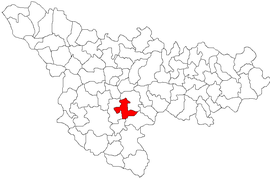Liebling, Timiș
Liebling (German and Hungarian: Liebling) is a commune in Timiș County, Romania about 30 km south of Timișoara. It is composed of three villages: Cerna (Temescserna), Iosif (Józsefszállás) and Liebling.
Liebling | |
|---|---|
 Location in Timiș County | |
 Liebling Location in Romania | |
| Coordinates: 45°35′N 21°19′E | |
| Country | |
| County | Timiș |
| Government | |
| • Mayor | Ioan Gheorghe Munteanu (PNL) |
| Population (2011)[1] | 3,723 |
| Time zone | EET/EEST (UTC+2/+3) |
| Vehicle reg. | TM |
History
The village was built by German (Banat Swabian) settlers in 1786 during the third great immigration of Germans during this period under Emperor Joseph II and settled with Protestants.
The community name derives from the administrator Baron Nikolaus von Vecsey. Apparently the commissioner of the colony wanted to name the village Veczehaza in honour of the Baron. The Baron declined this proposal and replied: "Nein, er soll Liebling heißen, denn die Protestanten sind meine Lieblinge." (No, it should be called Liebling [favourite], as the Protestants are my favorites.)
In 1880 there were 4,085 people, including 719 ethnic Romanians and 3,318 German-speaking Danube Swabians. In 1926, after the village and region was united with the Kingdom of Romania, 16 Romanian families from Transylvania were settled here. By 1941, there were 5,086 people, including 886 Romanians and 4,086 Danube Swabians. However, over 2,000 people (mostly German-speaking) fled the advancing Soviet army on 22 September 1944 with their Pastor Andreas Nagelbach. The Soviets deported over 100 German speakers to work in the USSR where about half died. The Communist regime settled over 2,000 Romanians in the empty houses.[2] According to the 2002 census there were 3,744 people, including 3,362 Romanians and 22 Germans.
The current Mayor is Ioan Gheorghe Munteanu. Liebling is about 76 metres above sea level.
References
- "Populaţia stabilă pe judeţe, municipii, oraşe şi localităti componenete la RPL_2011" (in Romanian). National Institute of Statistics. Retrieved 4 February 2014.
- http://www.novasoftware.biz/liebling-banat/liebling-banat.asp?WCI=Std&FID=130%5B%5D
